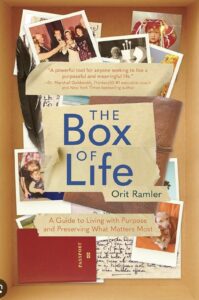This book particularly resonates with Paul O’Connor because it applies to a project he’s been involved in for quite a while, but, he says, this useful guide has a message for all of us.
Reviewed by Paul T. O’Connor
THE BOX OF LIFE: A GUIDE TO LIVING LIFE WITH PURPOSE AND PRESERVING WHAT MATTERS MOST. By Orit Ramler. Mascot Books. 287 pages. $27 hardcover.
I’ve been working on a family history for a decade now, and I wish I had read Orit Ramler’s The Box of Life before I got started. Better yet, I wish my great grandparents had done so, which would not have been possible because the book came out just last year.
Ramler is a personal and professional development coach who in 2002 befriended Charles Stern, then in his 80s, through her work as the director of a local branch of the Jewish Federation in North Carolina. Their friendship grew until, one day, he presented her with his box of life, a curated set of documents, photos and memorabilia of various sorts. Her assigned task was to organize this into his life story.
From that work, Ramler has developed a personal coaching service, and from that, her book.
One’s box of life is composed of what Stern collected, the most important items needed to tell future generations about their ancestors. Such a box is personally curated; there is no set formula, but the intent is clear: to preserve family narratives.
“Did you know that family narratives can be lost in three generations?” she asks. “I’ve learned that firsthand recently and I’m not surprised.”
I’ve learned it, too. As deeply as I’ve dug, I found little about my O’Connor grandparents and their parents – except that one great-grandfather spent a lot of time defending himself in court. I actually learning more about the people who put my mother in an orphanage. That’s because the second family shows up more in public records.
So, what does Ramler suggest we place in our box?
Start with what we know of previous generations. If a family tree exists, include it. Stories about grandma and grandpa, their origins, their lives. Then move onto parents. For the next generation, this will be ancient history, and if it is not captured now, it will be lost.
About oneself, Ramler suggests items related to work, play, travel and interests. Most important, the included material should be the story as we see it. We should define who we are.
Contemporary family members and friends should also be included. This is a perfect opportunity to exact revenge on one’s older sister, for example, for those many times she usurped your access to the family car because she had to wait tables to pay for college. So annoying.
Of course, Ramler goes into a great deal more detail. I’m summarizing in 600 words or less.
The Box of Life is not solely a how-to book on preparing family history. It is also a self-help, or self-awareness, guide, as the title says, a “guide to living with purpose.”
I most enjoyed the chapter on nostalgia. Often unfairly dismissed as sentimentality, nostalgia can help us find peace when we wander back to previous days, even if we see those days more positively than we did at the time. That’s the whole idea. We go to a nice place in our heads, kind of like imagining you’re at the beach and listening to the waves lap onto the rocks instead of listening to our president.
When we face so much uncertainty about the future, it is calming to remember when things turned out well in the past.
I would say the same about putting together a box of life. In these days when we don’t know what major change to our way of life will be announced tomorrow, it can be calming to sift through the old pictures, papers, news clippings and photos to tell the great-grandchildren just who you were.
